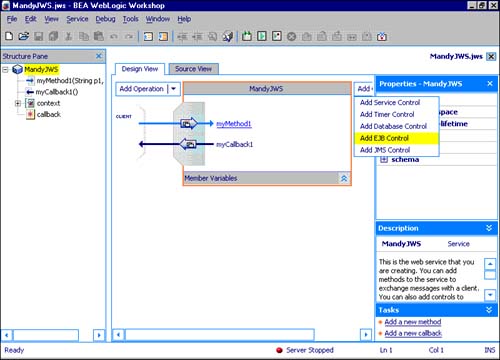Development Tools
| The first and foremost set of tools that will be discussed today are development tools. Development forms a core process of building applications in the WebLogic Server. Development tools enhance productivity and cut down development costs. Hence, an awareness and use of development tools is essential. Even though the WebLogic Server is popular in the market, no in-house visual IDE is available from BEA Systems. With the introduction of Web Services, though, things have changed. BEA has come out with a visual design and development tool especially targeted for developers of Web Services called the BEA WebLogic Workshop. A quick look will be taken at the different features offered by the BEA WebLogic Workshop. The second tool that will be looked at is JBuilder from Borland, which has been around for quite some time. BEA WebLogic WorkshopThe BEA WebLogic Workshop is a newly introduced visual development GUI tool used to develop, debug, and deploy Web Services applications on the WebLogic Server. Interestingly, in addition to using the WebLogic Workshop as a development and deployment tool, another significant area in which it will find use is as a design tool. The WebLogic Workshop tool provides a visual environment to model the interactions of client applications with Web Services. These interactions are then implemented as events. Developers can write the processing busing logic within these events. The remaining part of the Web Service, like the XML messages, SOAP envelopes, and WSDL descriptors, are automatically generated by the WebLogic Workshop. Apart from this, regular J2EE components, such as EJBs, JDBC connections, and the like, can be automatically deployed by the runtime framework built into the WebLogic Workshop tool. Building a Web Services application, as you shall study during the bonus day, is no easy task. A Web Service is made up of different infrastructure parts, like the XML messages, the SOAP protocol for communication, the WSDL service declaration file, and so on. The BEA WebLogic Workshop aids in easy and fast development of Web Services without the developer's needing to get into the nitty-gritty of writing the infrastructure parts. The main features of the BEA WebLogic Workshop are as follows:
To aid in the visual development of Web Services, the WebLogic Workshop contains the following ready-to-use controls:
Web Services developed in the WebLogic Workshop are stored in Java Web Services files with the extension .jaws. Figure 19.1 shows the WebLogic Workshop with the different controls available. Figure 19.1. Screen shot of the BEA WebLogic Workshop.
JBuilderOne of the most popular Integrated Development Environments (IDEs) for developing and deploying applications on the WebLogic Server is the JBuilder from Borland. JBuilder has been around for some time and provides a powerful yet easy-to-use visual development environment for developing, building, debugging, and deploying applications. JBuilder is a generic IDE and comes packaged with its own application server the Borland Enterprise Server. The interesting feature of JBuilder is that its Enterprise edition supports not only its built-in Borland Enterprise Server but also enables developers to integrate the JBuilder IDE for use with popular application servers like BEA WebLogic Server and IBM Websphere. The JBuilder version 7.0 Enterprise edition supports integration with BEA WebLogic Server 6.x; see Figure 19.2. Figure 19.2. Screen shot of JBuilder with support for the BEA WebLogic Workshop.
To use JBuilder as the IDE with BEA WebLogic Server, select the Configure Servers option. From the list of application servers, select the latest version of BEA WebLogic Server supported by JBuilder. Select the Enable Server checkbox and fill in the details in the General tab. You need to supply the different parameters, such as the home directory of the BEA WebLogic Server installation, location of the EJB compiler, JVM parameters, working directory for your applications, classpath of the primary library Java archive files of WebLogic Server, and so on. Save these options and start up WebLogic Server. You are all set to start using the JBuilder IDE in conjunction with the BEA WebLogic Server! Now let us go over some of the features of the JBuilder tool:
Finally, take a look at the JBuilder GUI when you open one of the EJBs that you developed over the past few days. Figure 19.3 gives an idea of the powerful features provided by JBuilder. Figure 19.3. Screen shot of opening an EJB using JBuilder.
|
EAN: 2147483647
Pages: 339
- Using SQL Data Definition Language (DDL) to Create Data Tables and Other Database Objects
- Working with Functions, Parameters, and Data Types
- Working with SQL JOIN Statements and Other Multiple-table Queries
- Monitoring and Enhancing MS-SQL Server Performance
- Exploiting MS-SQL Server Built-in Stored Procedures


